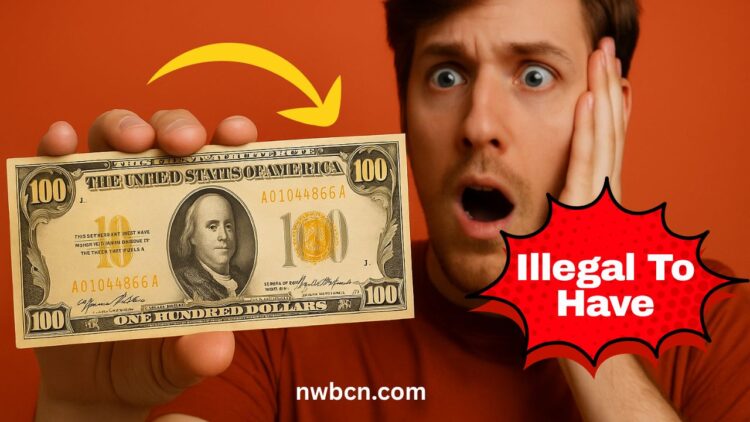Issued in 1928, the $100 gold certificate is part of the first small-size gold certificates, replacing large-size notes. These carried a distinctive gold treasury seal and were redeemable for gold.
Series 1928 included $10, $20, $50, $100, $500, $1,000, $5,000, and $10,000 denominations. Only the smaller ones circulated, and the $100 is one of the rarest survivors.
Why It’s So Rare Today
1. Gold Recall of 1933
In response to the Great Depression, the Gold Reserve Act of 1934 and preceding orders required gold certificates to be returned and surrendered. Private ownership was illegal, and most notes were destroyed.
2. Restricted Reboarding
Although the 1964 Treasury order legalized gold certificate ownership, they were never reissued. The 1928 $100 notes that survived were mostly canceled, melted, or held in government archives.
3. Low Survivorship
Small-size $100 gold certificates from 1928 are extremely scarce—most later series like 1928A weren’t issued (destroyed pre-release), and circulation survivors are few. Collector circles estimate only 100–150 examples of similar high-denomination notes exist.
Legal Status: Legal Tender But Not Circulating
- Not usable for gold redemption—post‑1964 gold certificates can only be exchanged for Federal Reserve Notes at face value.
- Legal tender at face value, they cannot be used in commerce because they’re worth much more to collectors.
- No restrictions on ownership since 1964, but using for transactions is impractical.
Collector Value & Price Trends
| Condition & Grade | Estimated Value (USD) |
|---|---|
| Circulated (VF–XF) | $1,500–$3,500 |
| Choice Uncirculated (AU–MS60) | $5,000–$10,000 |
| Certified MS62–MS64 (PMG/PCGS) | $10,000–$20,000 |
| MS65+ or star serial | $20,000–$40,000+ |
- eBay listings (AG to VF): $1,200–$4,800
- Pristine high-grade notes: PMG/PCGS-graded AU55 examples at $4,800; MS65+ rarities exceed $20,000.
What Collectors Look For
- Seal & serial features
- Gold Treasury seal on obverse.
- Fancy serials—low numbers or star notes—attract premiums.
- Paper quality & crispness
- High-grade notes have bright margins, no folds or spots.
- Certification matters
- PMG/PCGS grades confirm condition and authenticity.
- Eye appeal
- Clean, bold printing and centered margins significantly boost value.
Historical Significance
- Transition to small-size bills in 1928 marked a major redesign of U.S. currency.
- Gold certificates were written promises backed by gold, central to the U.S. gold standard era.
- The recall of 1933–34 represents a pivotal policy shift away from gold, making surviving certificates symbols of a bygone era.
Key Facts About 1928 $100 Gold Certificates
| Feature | Details |
|---|---|
| Series Year | 1928 |
| Seal Color | Gold treasury seal |
| Dimensions | Small-size (same as modern notes) |
| Original Redemption | Redeemable for gold until 1933–34 |
| Legal Tender Status | Redeemable for silver/U.S. notes—no gold redemption |
| Illegal Ownership Period | 1933–1964 |
| Mall survivorship | Very low, few in collector hands |
| Estimated extant notes | 100–150 total small-size hi-denominations |
| Value Range | $1,500–$40,000+ depending on grade and certification |
| Collectors prize | Crisp uncirculated with fancy serials and certification |
| Not redeemable in gold | Only face value redemption available |
| Certification drive | PMG and PCGS certified examples lead market |
Why Collectors Chase This Note
- Extreme rarity—few survived and even fewer in high grade.
- Historic connection to gold standard and Great Depression reforms.
- Aesthetic appeal—crisp printing, gold seal elegance.
- Investment potential—values have risen sharply, outperforming many coins/bills.
Real-World Buying Tips
- Buy graded notes—look for PMG/PCGS holders to ensure condition and authenticity.
- Inspect serials—fancy patterns can add 50–200% to value.
- Avoid cleaning or damage—any manipulation cuts value drastically.
- Check provenance and pedigree; bills with auction history or established collections are safer purchases.
The 1928 $100 gold certificate is not just a banknote—it’s a piece of monetary history, emblematic of the gold standard and a seismic shift in U.S. economic policy.
Its scarcity, legal evolution, and collector appeal have made it one of the most coveted pieces of small-size U.S. paper money. Today its value ranges from a few thousand to tens of thousands depending on grade and rarity.
For serious collectors and historical enthusiasts, it remains a must-have treasure—a tangible link to an era when the dollar was gold-backed, and a testament to changing economic landscapes.
FAQs
Q1: Can I still spend a 1928 $100 gold certificate for $100 today?
Yes—it’s legal tender and redeemable for face value. But using it in commerce is rare and impractical due to collector value.
Q2: When did ownership become legal?
Private ownership was illegal from 1933 to 1964. It became legal again in 1964, though redemption remains for face value only.
Q3: How can I verify a note’s authenticity and grade?
Use PMG or PCGS graded notes—they seal and certify condition. Look for high grades (MS or AU) and ensure seals and serials match 1928 issues.
